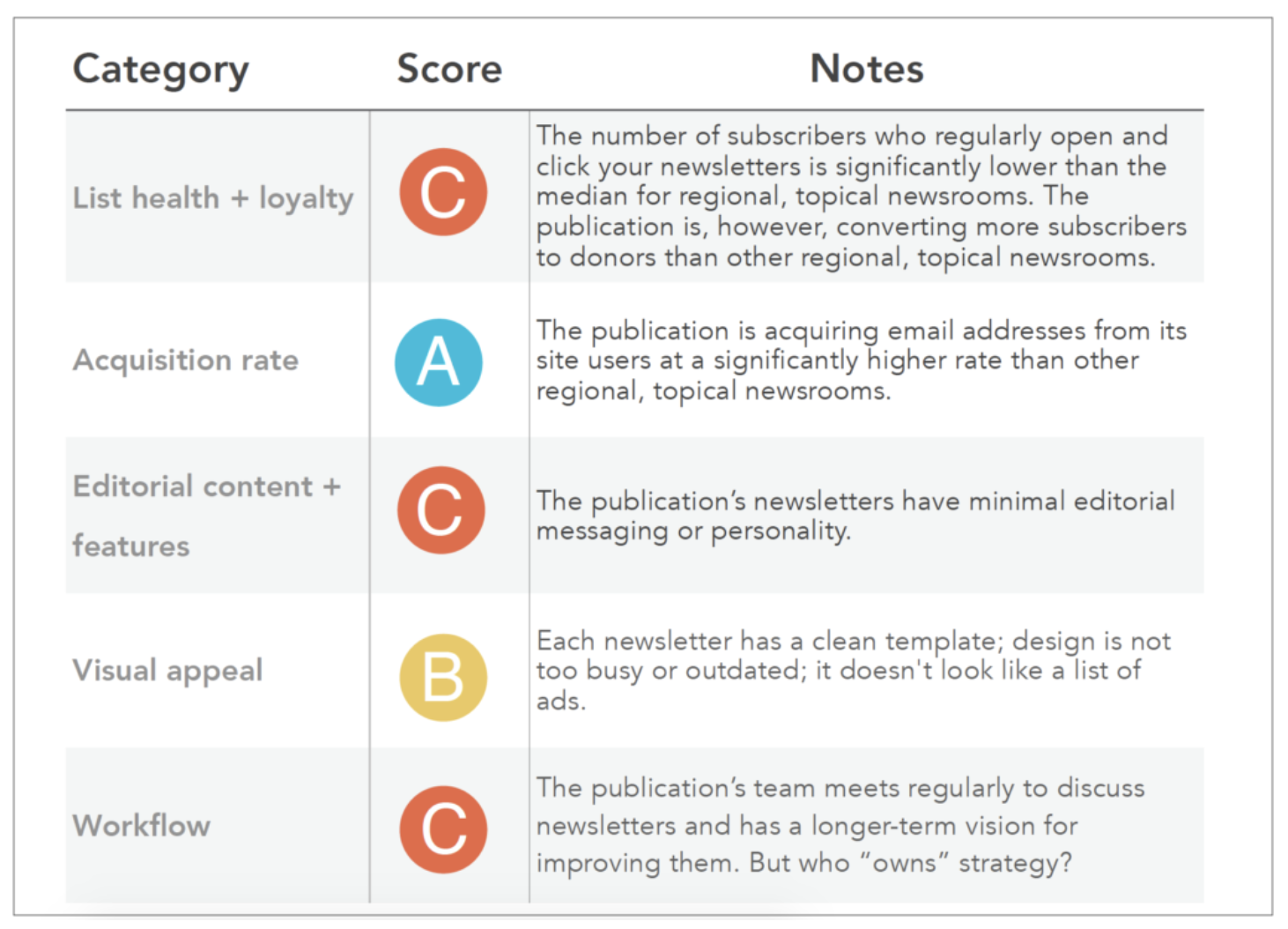Newsletters Are Crucial for Reader Loyalty. Here’s How to Make the Most of Them.
Email newsletters can be a powerful tool. Effective newsletters can help news organizations reach new audiences, deepen engagement, and build loyal relationships—all things that the Google News Initiative Audience Lab is focused on.
The GNI Audience Lab, a partnership between the News Revenue Hub and the Google News Initiative, has wrapped up assessments for seven digital native publishers around four key areas that impact audience growth: loyalty, SEO, newsletters, and organizational structure. For most of these areas, the Lab created scorecards that measure how each newsroom is performing. Every assessment also comes with customized recommendations for how newsrooms can improve their approach.
The Lab’s last round of assessments focused on the cohort’s email newsletters, specifically on how they influence the loyalty of existing readers and serve as a gateway product for newer readers. We examined five different aspects of the cohort’s newsletter products: List health (or loyalty), acquisition rate, editorial content, visual appeals, and workflow.
The cohort includes local outlets Bethesda Beat and Rivard Report; regional publications Bridge Magazine and CalMatters; and national organizations the Center for Public Integrity, the Center for Investigative Reporting, and Next Avenue. All seven organizations received newsletter scorecards, as well as recommendations on how to improve their offerings.

Here are four solutions the Lab recommended, and how to make the most out of them:
Add an editorial voice to engage your audience
Most newsrooms in the Lab’s cohort struggled with both newsletter list health and editorial voice, which suggested that they need to re-think strategies to make their products more engaging.
If a newsroom had an automated, RSS-style newsletter with little editorial voice or content, the Lab’s recommendation was to append an editorial note at the top of the email. The workflow is slightly more demanding, but the aim is simple: to see if injecting more voice directly into newsletters will enhance reader engagement and loyalty.
Get feedback from your audience on what they want to hear about
Another Lab suggestion for each newsroom was to counter low engagement rates by talking directly to subscribers. One simple suggestion, for example, was to embed links to a reader survey in newsletters for a set period—an opportunity to get some product feedback from readers.
Adopt a testing culture for continuous improvements
It was also common for newsrooms to overlook consistently testing their products. To counter this issue, the Lab gave each newsroom a variable to begin testing—usually an A/B test of subject lines, length, or time of day, depending on the product. (The Lab generally recommends testing one variable at a time, and to conduct each test for a period of several weeks, if not months, to get cleaner test results.)
Longer tests also help to establish a culture of experimentation within the organization, as opposed to one-off tests to improve one feature of the newsletter. The approach moves the newsroom further away from the set-it-and-forget-it approach to robust product development.
Invite readers to sign up for newsletters throughout their journey
Low acquisition rates were also present across the cohort—a troubling sign that readers aren’t finding organizations’ newsletter sign-up features. Most acquisition rate strategies take place outside of the inbox. For example, research inside the News Revenue Hub shows that month-over-month email list growth is higher for Hub members that deploy an email sign-up on their website. We suggest strategically placing email sign-ups on all article pages, on the homepage, and anywhere that content is distributed, including on-air callouts for podcasts.
“Our research suggests that actively working to convert site users to newsletter subscribers has a downstream impact on revenue,” said Rebecca Quarls. She continued: “That’s why we help our cohort aggressively pursue subscribers and build reader-first newsletter products.”
“Our work with the Audience Lab has definitely provided a new perspective on newsletters,” said Amélie Ward, marketing and events manager of Bethesda Magazine and Bethesda Beat. “In this current climate there are so many ways for our readers to digest the news, so it’s helpful to reevaluate our content and presentation in order to be a relevant and easily consumable news source for our community.”
The Lab’s suggestions for Bethesda Beat include appointing someone dedicated to helm newsletter strategy, content, and design; identifying measurable short- and long-term newsletter goals; and adding editorial content and personality beyond headlines to emails.
Ward said they are already putting the recommendations into practice. “Most recently, we A/B tested our subject lines,” she explained. The newsroom sent a generic subject line to half of their email list (e.g. “The Latest News from Bethesda Beat: Monday, Dec. 3”), and a specific subject line to the other half (e.g. “Breach Exposed Nearly 6,000 MCPS Students’ Data”). The results were obvious, said Ward. “We found that we had a higher open rate and click-through rate on more specific subject lines. We also found that subject lines which played better to reader curiosity led to higher open rates, by an average of about 5 percent.”
“Readers’ inboxes are increasingly crowded and competitive spaces,” said Sibel Lowin, global partnerships solutions lead for Google News Initiative. “We’ve seen some cohort members build newsletter products that stand out by replacing automated formats with curated ones. Adopting a stronger, more compelling editorial voice has fundamentally improved engagement metrics for those news organizations.”
Lowin added that she’s encouraged by the way small, tactical newsletter changes can make a big impact on audience engagement. “Our goal is to help surface more of these strategies for news organizations around the world, and ultimately help them drive growth.”
So what’s your plan to improve your newsletter products? The Lab has one recommendation: Pick one thing from the list above and get started!